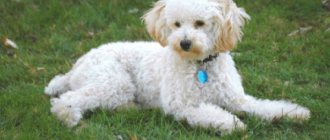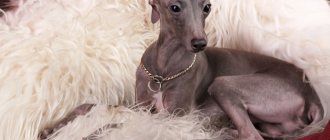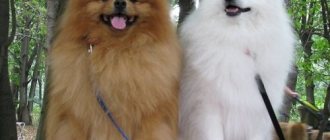Origin story
The Pomeranian standard first appeared in English culture in the eighteenth century.
At this time, Queen Charlotte brought with her a small cream-colored dog in her dowry. All the courtiers were delighted with her. Then the breeders began their work, trying to export their varieties of the breed. Soon, Queen Victoria's granddaughter brought a Spitz named Marco from Italy, but he was very small and weighed only five kilograms. This dog became the ancestor of the royal line of the breed. It is known from history that Queen Victoria organized the first Pomeranian club in 1871, where the standard was adopted.
The Pomeranian Spitz, a photo of which is in this article, has changed a lot over time, just like the standards that were once established. Not only has the size changed, but the range of shades of this dog’s coat has also become much wider. Since 1871, German breeders have been breeding Spitz dogs. Then the Americans became interested in the breed. Already in 1909, an exhibition of American line Pomeranians was organized. This contributed to further popularization of the breed.
Today there are two main lines: German and American, which have excellent appearance and excellent characteristics.
Types of oranges
Today there is an FCI German Pomeranian standard. It is sometimes called the Fox Spitz or the Bear Spitz. It is known that another type is distinguished separately - the puppet type. This breed has long been recognized by kennel clubs in England, Canada and America.
These dogs are distinguished by a small body, ideal physique, beautiful coat and amazing intelligence. It is known that the standard Pomeranian Spitz, the characteristics of which are of interest to many, includes the following parameters: German origin, height at the withers is approximately twenty centimeters, but can fluctuate within two centimeters.
By nature, the Pomeranian is quite intelligent and very active. You should always develop it not only physically, but also mentally. This Spitz gets along easily in families and quickly begins to make friends not only with children, but also with other animals. The dog got its name from the German region of Pomerania, where fluffy white dogs of short stature, whose weight could reach fifteen kilograms, have long been bred. They were used mainly to protect a person’s home and property. Such dogs were called either “Pommer” or “Pommirle”.
The dogs were dark in color and lived in Swabia. Because they were excellent guards, people called them "Spitzers." The largest individuals reached a height of sixty-three centimeters at the withers. They were called Wolfspitz or Wolfspitz. Many dogs were gray in color with spots.
Dogs of this breed should have free, easy and smooth movements. The Pomeranian's step is always confident, but it becomes a little springy when he runs. He does not place his paws wide, and his joints should not be turned out. The pet owner must take care of this at an early age.
How to choose a puppy
When choosing a puppy, you should definitely keep in mind that as the dog grows, its color may change, and the full color is revealed only by 3 years. The hardest thing will be for breeders who bought black and white dogs - already in the second month of life, a dark coat may lighten, and a light coat, on the contrary, may become darker or reddish. Considering that puppies are bought at an earlier age, it is better to focus not on the color of the hair, but on the pigmentation of the mucous membranes. So, if a dog has black lips and eyelids, it means that the animal will retain its dark coloring.
We invite you to familiarize yourself with: Feed standards for broilers: consumption table, video and photo
When buying white puppies, you can be guided by the ears - if the fur growing behind them has a brown tint, then as the dog grows, the coat will change its shade to cream or beige.
Before buying a Spitz dog, it is important for the future owner to know everything about the breed. Before choosing a puppy, the owner needs to decide for what purpose he is buying it. The pet can be purchased as a pet and family friend, as well as for use in further breeding or performance in circus programs. The price of the dog depends on this.
The breeder must provide veterinary passports, show titles of the puppy's parents, as well as test results for the absence of genetic diseases.
Upon purchase, the breeder gives the owner the puppy’s veterinary passport and birth certificate.
German Spitz puppies must meet the breed standard
The German Spitz is friendly and has a balanced character. The dog will become a wonderful friend for single people leading an active lifestyle, and will fit well in families with children. Your pet will be comfortable both in a country house and in an apartment, because these dogs are very unpretentious and take up little space.
The nickname of a German Spitz should be short and easy to pronounce, and contain sonorous letters. It is better to give preference to foreign names, or focus on the appearance and character of the pet.
Here are a few nicknames that will suit a Spitz:
- Lilith;
- Bang;
- White;
- Blackie;
- Weasel;
- Yuna;
- Kevin;
- Elvis;
- Chapa;
- Torah;
- Bruna;
- Poldi;
- Sven;
- Ralph.
The German Spitz will be an excellent companion and devoted friend to the whole family. If you follow simple rules of care and nutrition, your pet will delight its owner with its good nature and new skills for many years.
Spitz color: what to look for when choosing a puppy
The colors of Spitz dogs depend on the colors of their ancestors. When choosing a puppy, you should definitely inquire about the color of its parents, as well as all its known relatives. This will increase the chances of choosing a dog with a color that meets the requirements of the standard. After all, if a puppy has ancestors with a different color, he may develop tan marks or spots of a different color after some time. Spitz puppies' colors can change after their first shedding. For example, the color of a black Spitz puppy may initially be dark gray.
To understand what the pet's color will be, you need to carefully examine the fur behind the puppy's ears. This is exactly what his color will be when he grows up, but this method does not provide a 100% guarantee. If a puppy is purchased for participation in exhibitions, then it is better to reserve it and pick it up after the first moult, when the color has finally appeared and will no longer change.
We suggest you read: What do tits eat in winter? — sinichku
Walk
German Spitz are very active and love frequent and long walks. You need to walk your pet 2-3 times a day. It is advisable to diversify daily walks with games and training elements; the dog will be happy to overcome various obstacles and new routes.
The duration of walks depends on the age of the animal. The first walks should last no more than 20 minutes, gradually the time can be increased to 2 or 3 hours, depending on the weather and the owner’s ability to allocate time for this.
We suggest you read: How many years do British cats neutered at home live?
Advice! You should not walk during heavy rain, wind or snow, as your pet may catch a cold.
When walking in crowded places, your pet, despite its miniature size, must be kept on a leash. Due to its activity and curiosity, a pet can run out onto the road or run far from its owner. Also, dogs of this breed tend to be dominant, so there is a high risk of conflict with larger dogs, which can lead to serious injury or even death of the pet.
Your pet must be kept on a leash while walking
Characteristics of the bearish type
It is known that this type of Spitz did not find support in any of the standards. But this did not at all affect the popularity of animals. Despite the fact that the standard of the bear-type Pomeranian has not been approved, in our time this type of Pomeranian is considered the most fashionable. It's hard to resist a dog with a small round muzzle and button eyes that remind him so much of a teddy bear.
The ears of representatives of the breed are also small and slightly rounded. The legs are dense and short. With their funny appearance and small size, these Spitz dogs are somewhat similar to a teddy bear. This dog is very energetic and restless. He is always cheerful, but can also be quick-tempered. He needs constant communication, he is devoted and faithful.
German Spitz standards
In the German Spitz breed, the colors recognized by the standard depend on the breed variety.
According to the standard, a Wolfspitz or Keeshond must have a wolf color or one of the shades of gray. The wolf color is characterized by zonal coloration of the guard hairs. Typically, these dogs have a silver-gray coat with black tips. The muzzle and ears should be dark. The area around the eyes is outlined with a thin black line.
In the Gross Spitz or Large Spitz breed, the standard colors can only be black, white or brown. Moreover, the color must be uniform and monochromatic; the presence of spots is considered unacceptable. The color reaches its depth only at three years of age.
According to FCI standards for the Medium, Small and Pomeranian Spitz breeds, the colors can be of the following colors:
- black;
- white;
- brown;
- orange;
- zonal gray;
- other.
Usually the color is solid, but two-tone color of the breed is also acceptable. For the Medium, Miniature and Pomeranian breeds, colors can vary greatly and the term "other colors" includes black and tan, cream, cream and sable, orange and sable, particolor or spotted. In spotted dogs, the base color should be white and the spot color may be black, orange, brown or grey. The spots should be evenly distributed throughout the body.
In a black Spitz, the black color extends to the skin and also to the undercoat. The presence of even small spots of a different color is unacceptable.
A brown (chocolate) Spitz should have a uniform color, without darker or lighter areas. Darker shades of wool are prized. In chocolate dogs, the eyelids, lips and tip of the nose may match the color of the coat.
The white color of the Spitz does not allow the presence of yellowness. Sometimes yellowish spots can be found on the ears, this is considered a defect.
Orange color suggests a uniform color of medium intensity. It is especially popular for Pomeranians. Uniform coloring without sharp transitions is valued. A sable-colored Spitz can have a color of varying intensity. These dogs have a zoned gray guard coat and a cream, orange or gray undercoat. The muzzle and ears must be the same color.
General appearance and proportions
The Pomeranian Spitz standard describes the appearance as follows: the dog must have a lean and strong build. The beautiful coat with a thick undercoat forms a “collar” on the neck, similar to a mane, and “pants” on the hind legs. The hairs are almost perpendicular to the body. The muzzle is distinguished by a pointed nose, round eyes and erect small ears, and has a “smiling” expression. There are no folds of skin on the body; it fits tightly to the body without sagging or sagging.
A purebred dog should have a square body format. The height to the withers is related to the body length as 1:1. The head is small and wedge-shaped. The occipital protuberance is not very pronounced. The muzzle should be shorter than the forehead and should be related to it as 2:3 or 2:4.
The height of the orange is 18-22 cm. The weight corresponds to the size of the pet. Experts allow brown, orange, black, white, zone-gray colors for the dwarf Spitz. The dog's coat should be formed by the age of three.
Pomeranian breed standard
The standards are set by 3 recognized world clubs:
- American Kennel Club (The AKC)
- Quennel Club (The KC)
- International Canine Federation (The FCI). Official representative in Russia - Russian Cynological Federation (RKF)
The weight of an adult Pomeranian after one year, according to the AKC (American Quesnel Club) standard, should be in the range from 1.36 to 3.175 kg. These values are averages: dogs can weigh either less or more. And there are reasons for this. We will talk about it later. Kennel Club - English standard (The KS) allows smaller Spitz sizes: 1.8 - 2.5 kg for females and 1.8 - 2 kg for males.
We invite you to familiarize yourself with: Catnip (23 photos): what is it? Description of catnip. How does it work on cats and kittens? How to use catnip sticks and dried plant?
FCI - Federation Cynologique Internationale determines the breed standard not by weight, but by the height of the dog, namely height. According to their rules, the size of an adult dog should be 18-22 cm from floor to withers. This is lower than the AKC standard, which ranges from 20.32 - 28 cm.
See the Spitz weight table by month here
It is almost impossible to know the size of a dog until a certain age. An honest breeder will never be able to guarantee you what size the puppy will grow up, knowing these features. With the exception of unusually small puppies at birth. It is possible to understand what size an adult dog will be starting from the age of 6-7 months.
Some individuals are born smaller than normal. Why is this happening? Breeders involved in breeding Pomeranian Spitz periodically face the fact that at least one puppy in the litter is born smaller than the rest. This happens from time to time and is considered normal when breeding small dog breeds.
Large size
Just as when Pomeranian Spitz are born, the litter contains puppies that are smaller and larger than the standard. In most cases, the genetics of more distant relatives in the pedigree are to blame. A large dog usually has a larger bone structure and is taller at the withers.
Another reason for the large size of Spitz dogs may be the past of their ancestors, which periodically reminds itself of itself. After all, these animals, before their reduction, were medium and large sized sled dogs. They had snow-white fur, and their closest relatives are the American Eskimo Spitz.
How old do Pomeranians grow?
During the growth period of up to 6 months, these babies gain height and weight quite quickly. But some of them grow rapidly even up to 9 months. Then growth slows down and gradually approaches the standard by the year. In addition, if there is a genetic predisposition to this, Spitz dogs can grow up to 15 – 18 months.
We continue to consider the features of the Pomeranian Spitz. The breed standard includes the following characteristics: height is no more than twenty centimeters at the withers, and weight is no more than three kilograms. The larger the representative of this breed, the easier childbirth is for her. This has been repeatedly confirmed in practice.
Pomeranians have a medium-sized head and a wide forehead. The animals have an elongated muzzle and dark lips. Their teeth are small and have a scissor bite. The ears are constantly standing and located close to each other. The slanted eyes of the Spitz make the expression of such a dog’s muzzle cunning. Despite the fact that the Spitz's neck is proportional to the size of its body, it is not at all visible due to its thick coat. The Pomeranian's chest is wide and the back is straight. The tail is set high and constantly curled into a fluffy ring.
General description of the breed
The weight of dogs of this breed can be from 1.5 kg to 30 kg. Height also has a large range - from 22 cm at the withers to 55 cm.
The variety of colors of this breed will surprise even an artist: brown, black, white, gray and, of course, orange (red). If you like a mixture of different colors, then this breed also has what shades to choose from: sable, black and tan, all shades of red with spots of different sizes, wolf. But a white tie on a black Spitz in the shape of a white spot is grounds for refusing to breed the pet. The miniature white Spitz looks very impressive in large modern homes.
A pet will only be considered an adult at the age of three. By this time, he will appear before the owner in all his glory. The large collar neatly fits the small, intelligent head with intelligent eyes. A magnificent tail, as an addition to his wonderful fur coat - what could be more unusual in a pet? This miracle dog will live 12-15 years. With skillful handling, love and friendship, some individuals can please the owner for 20 years.
Photo of a dog on the lawn
The German Spitz is an active, cheerful dog. He is very sensitive to the mood of the owner, to whom he is very attached. Representatives of this breed are smart and easy to train. Distrust of strangers and the desire to join the fight make the Spitz into a little warrior. Unpretentiousness to weather conditions and resistance to diseases distinguishes this dog from other miniature breeds. These dogs can safely get into fights with their relatives, because fearlessness is one of the breed’s characteristics. But such character traits as cowardice and aggression are disqualifying breed defects.
Coat color
If earlier Pomeranian Spitz were only white or sandy in color, now, through selection, representatives of the breed with a red coat color have appeared. It is important to know that the coat of such a dog is thick and luxurious, and therefore requires special attention and care. Currently, you can find the following colors of oranges: cream, blue, white, orange, sable, brown, rich red and black.
We invite you to read: Description of the German Spitz breed
Many people prefer to have white dogs. However, a pure shade without blemishes is quite difficult to find.
But what colors does the standard allow? The Pomeranian Spitz is divided into three groups according to its color, into which they are distributed at specialized exhibitions. The first is Pomeranians, which have sable, cream or orange shades of fur. The second are individuals with a black, blue or brown color.
Buying a dog
Buying a dog is a responsible matter. You need to decide why the owner needs the dog. If you plan to breed and sell puppies, then you should pay attention to adult puppies with expert assessments from the exhibition and diplomas. If the dog is purchased as a companion and family friend, then you can choose a puppy.
German Spitz puppies
The most important thing when buying a purebred dog is the documents. There must be a veterinary passport with notes on all vaccinations, where the breeder will enter your information as the owner of the dog. The dog's name is also indicated in the passport.
The second document will be the puppy's metric, which should be replaced with a pedigree. The number for this puppy is indicated in the metric, and the baby will have a tattoo with the same number on his tummy or ear.
Some nurseries
Popular nurseries where you can buy a German Spitz:
- nursery Hamesha Star & Ksyushkin` S in the Moscow region - keeshond-souz.jimdo.com;
- Keeshond nursery "Olympic Spirit" in Novosibirsk - keeshond.su;
- nursery of Pomeranian Spitz "Mini Gum" in Moscow - xn—-dtbhbnblxv5etag.xn—p1ai/;
- Keeshond kennel “A staldo N armo in Minsk” - wolfspitz.by.
What to look for when buying a puppy
When buying a puppy, you should pay attention to the tummy - it should be voluminous, and the belly button should not stick out. This simple examination will save the owner from surgery to remove an umbilical hernia.
The puppy should not have dewclaws on its hind legs - they can subsequently cling and bleed.
The puppy's eyes should be clean, without discharge or mucus.
Healthy puppy
Pay attention to the puppy's character. The baby must be curious, but careful, because those who come to visit are of enormous height, speak a language incomprehensible to the puppy, have their own smell, their own manner of movements and timbre of voice. To a puppy, they seem like aliens, so how can you not bark?
Puppy cost
There are hundreds of nurseries for breeding German Spitz in Russia. Depending on the region, the price may vary. The more champions a nursery has raised, the more expensive the price of Spitz dogs from that nursery. The cost for a two-month puppy is from 10,000 rubles to 120,000 rubles.
During the first year of life together with a German Spitz, a wonderful world of discoveries and inspirations, insights and smiles awaits the owner. Remaining a joyful and sweet friend for the whole family, the Spitz is ready for any discovery, trying to be a necessary and devoted dog.
Its cute appearance and playful character will be appreciated by both children and the elderly. Cleverness and easy training will appeal to young people and married couples.
Disqualifying defects in the color of Spitz dogs
White spots in dogs of other colors are considered serious defects. These may be small and inconspicuous spots in the chest area and on the tips of the paws.
A nose that is not black is also considered a defect. It can only be brown in chocolate Spitz dogs. By the way, in winter, orange and cream Spitz dogs may have a slightly lighter nose, but this will not be considered a fault.
Ask a Question
The most popular are orange Pomeranians that look like little foxes. They are cheerful and carefree. And their bright color pleases the eye. Which color do you think is the most pleasant?
Dog trimming
Pomeranians' fur requires careful care. It needs to be brushed regularly. This procedure should be carried out no more than four times a week, otherwise the dog will lose its undercoat. For combing, first use a slicker brush, and then a regular comb.
Trimming is mandatory for dogs of this breed. Without combing out dead hair fibers, the dog will not have a neat appearance. Careful care is needed both to maintain the pet’s health and to maintain the standard. Pomeranians need hair removed along the edges of the ears, around the anus and toes, on the hips, and on the backside. If you violate these rules and go beyond the permitted boundaries, then at the exhibition you may even be fined for such a haircut.
Caring for a Pomeranian Spitz at home
Before you buy and introduce a new pet into your life, you should read everything about the Toy Spitz breed, and then prepare your home for its arrival. Indeed, in the first weeks of the life of a new household member, it is important to diligently show care and attention. Let's look point by point at what it is advisable to do:
- Slippery floor surface. If the puppy slides on the floor, problems with its hind legs may occur. It is recommended to put a rough covering on the floor if it slips. This is a temporary need; as soon as the puppy grows up and gets stronger, the covering can be removed.
- Open door to the balcony. If the balcony is not glazed, the door there should always be closed.
- Electric wires. For any breed of dog, live wires lying on the floor are dangerous. The puppy can get carried away and chew them.
- Small items. They also need to be removed from reach. It's simple, the puppy will swallow it and choke.
- Trash bin. The garbage container should be in the nightstand behind the door, otherwise you will constantly pick up scattered waste from the floor, and your new friend may get poisoned.
- Chemicals. Household cleaning products should also be kept out of reach of the Pomeranian dog, for obvious reasons of possible poisoning.
- Unstable objects. Make sure that nothing falls on top of your Pomeranian puppy. For example, a pet can pull the iron by its dangling cord and pull it onto its head.
- Crevices and secluded places. Pomeranian puppies are very tiny, so it is better to cover the bottlenecks in advance, especially if it will be difficult to get him out of there. After all, a little ball will definitely get there.
- Elevation. If you put your furry friend on the sofa, don't forget to put him down on the floor before leaving. Pomeranians generally do not jump well, and the puppy may even get injured.
- Place. Puppies of all breeds sleep a lot, so prepare a cozy sleeping area.
- Toilet. Decide before purchasing whether the puppy will go to the toilet outside or inside the diaper. Babies should be immediately taken to the same place; it is not recommended to move the tray. Otherwise, the animal will get confused and will shit anywhere.
- Bowls. And finally, the most important thing. Decide in advance where bowls of water and food will be placed for your Pomeranian puppy.
How to wash a Spitz at home
The Pomeranian has a luxurious coat, so the question immediately arises: “How to care for a Spitz’s coat?”, “How often can you bathe a dog?” The dogs are bathed 2 times a month. More often, veterinarians do not advise this, as the protective layer is washed off, and the coat becomes dull and brittle. Dandruff may even appear. Of course, if the animal gets very dirty, it needs to be washed, and not wait for the next scheduled bathing day.
When can you bathe a puppy for the first time? It is better not to carry out water procedures before the main vaccinations. After that, you can safely begin accustoming to water. This usually occurs when the child reaches three months of age.
An adult orange is washed in the bathtub, after placing an anti-slip mat on the bottom; if you don’t have one, you can use a large towel. The dog is washed under medium flow from the shower. The water temperature should be around 38 degrees Celsius.
First you need to wet the fur, while making sure that water does not get into the ears. Then they lather the fur with a special shampoo for dogs, excluding the face. You should not rub too hard to prevent a lot of hair from turning into tangles. The fur takes a long time to wash, as this breed has a thick coat. You can also use a special conditioner to make the fur shine; it also needs to be rinsed off thoroughly.
After water treatments, the animal is wrapped in a towel for 10 minutes. Then blow dry until completely dry. It is important to know that before bathing you should close all the windows so that there are no drafts and the animal does not catch a cold. After bathing, you should absolutely not go outside, so you should wash your dog before going to bed.
Spitz shedding
Representatives of the Pomeranian Spitz breed shed seasonally, that is, twice a year. Seasonal molting occurs in autumn and spring. Bitches can still shed during heat and after giving birth. The first molt begins at about three months of age. There will be no hair lying around the apartment, since due to the thick fur, the fallen hairs remain inside and get tangled. Therefore, furry cats should be brushed regularly, especially before and after bathing.
How to properly comb a Spitz
First you need to choose the right comb. For thick undercoat, it is worth having three types of combs at home:
- Massage brush. It is worth starting to comb your pet with it. Using a massage brush, tangled hair is straightened. With daily use, you can prevent the occurrence of tangles and make your dog look fluffy and presentable. It is also used when drying with a hairdryer.
- Puffer. Dogs do not like this type of scratching because it can cause pain. But unfortunately, there is no way to do without it. This is the main weapon for combing thick fur. The fur is divided into partings and scratched from the base to the tips of the hairs in different directions, thereby removing unnecessary hair.
- Combs-combs. The final stage of combing is performed using combs with metal teeth. They collect the remaining fluff and make the fur more voluminous and erect.
Spitz vaccinations by age table
At the age of two months, the puppy must receive its first vaccinations. Previously, it makes no sense to do them, since the puppy is protected by antibodies obtained from the mother’s milk. After two months from birth, the Pomeranian puppy’s immunity begins to decline. At this time, it is necessary to carry out the first vaccination, and then adhere to the vaccination schedule. Before getting a pet, you should familiarize yourself with the vaccination plan, because the Pomeranian Spitz needs care and careful care from its owner.
Spitz vaccinations schedule by age:
| Disease | Primary vaccination | Second vaccination | Revaccination | Vaccination frequency |
| Rabies | 12-13 weeks | — | At 1 year | Annually |
| Infectious hepatitis | 8-9 weeks | In 3 weeks | At 1 year | Annually |
| Carnivore plague | 8-9 weeks | In 3 weeks | At 1 year | Annually |
| Enteritis parvovirus | 8-9 weeks | In 3 weeks | At 1 year | Annually |
| Leptospirosis | 8-9 weeks | In 3 weeks | At 1 year | Annually |
| Parainfluenza | 8-9 weeks | In 3 weeks | At 1 year | Annually |
| Ringworm | 2-6 months | In 2 weeks | At 1 year | Annually |
Temperament
By its nature, the Pomeranian is a smart dog who understands everything perfectly. But he is often wary and suspicious. Sometimes these qualities of his turn out to be unnecessary. He gets along well with children, as he is curious and emotional. He's so touching. Spitz always feels the child’s mood and will be faithful and devoted to him to the end.
Both children and adults are captivated by the infectious and magnificent “smile” that the Pomeranian gives to its friend. If the child is under five years old, then you should not get such a breed, since the Pomeranian does not like to be squeezed or cuddled.
Pomeranian breed standard
Often Pomeranians have deviations that do not meet the standard. They cannot participate in dog shows. Such deviations may include anatomical defects, as well as the dog’s flat skull. If the orange has too large eyes or they are too light, this is also considered a deviation from the norm.
Disadvantages include a light nose, as well as sudden and incorrect movements of the dog. If a dog has an incorrect bite, this will also be a deviation from the norm. Pomeranians may have semi-erect ears and inverted or everted eyelids.
If a Spitz meets all standards, then it is monitored from birth. However, for friendship and love it is not at all important whether or not the pet has deviations from generally accepted parameters.











